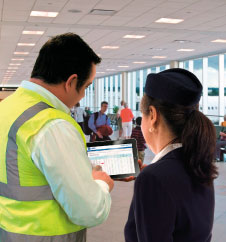
McMillan: “Our current forecasts indicate that by 2018 there will be unsatisfied demand of over 100,000 flights as a result of airport capacity constraints – some 1% of European flights.”
According to McMillan, achieving a more efficient system and better integrating airports into the aviation network is vital to the future of the industry. The Single European Sky (SES) initiative, which is aimed at meeting future airspace capacity and safety needs, and the SESAR (Single European Sky ATM Research) programme, which focuses on building the future European air traffic management system, are both of great importance.
“In the last few years, the focus in Europe has clearly shifted away from capacity and towards cost and efficiency,” McMillan said. “However, our current forecasts indicate that by 2018 there will be unsatisfied demand of over 100,000 flights as a result of airport capacity constraints – some 1% of European flights. So, there is still more to be done to see how airports can become more efficient. A key element of this is improving the links that airports have with the network.”
Crucial to this is the Airport Collaborative Decision-Making (A-CDM) programme, which is based on collaboration between all airport stakeholders, including airport and aircraft operators, ground handlers, air traffic control and network operations. The project aims to improve the overall efficiency of operations, with a particular emphasis on the aircraft turnaround and pre-departure sequencing process.
McMillan said: “We have seen real benefits for those airports that have adopted A-CDM. As more and more airports follow suit, we can expect additional benefits for the network as a whole as predictability improves.”
In 2008, ACI EUROPE and EUROCONTROL signed a collaboration to increase operational efficiencies at Europe’s airports, which involved the launch of an Action Plan for the rollout of A-CDM. An update on A-CDM is provided each year at ACI Airport Exchange, and at the 2010 event CANSO officially signed up to the A-CDM Action Plan.
The implementation of A-CDM, McMillan stated, is a win-win for all parties involved. “It helps the air navigation service providers to run their airspace more effectively; it helps the airport utilise all their infrastructure more efficiently, including their runways; it helps the airlines, who should experience fewer delays and less fuel burn; and, most importantly, it should help provide a better travel experience for passengers.”
Implementing A-CDM
This message has clearly been well received by a number of Europe’s airports. Four airports to have implemented it are Munich, Brussels, Frankfurt and Paris-Charles de Gaulle.
With such clear advantages, along with wider industry initiatives such as SES and SESAR, A-CDM has a key role to play in ensuring that every aspect of the airport of 2020 is as efficient as possible.

Customisable A-CDM solution
Airport Collaborative Decision Making (A-CDM) is now a mature concept, with a number of major airports in Europe having fully implemented the approach. Many more have A-CDM projects running, and the philosophy is now gaining acceptance beyond the EUROCONTROL states, particularly in the high growth Middle East and Asia-Pacific regions.
With this increasing maturity of the A-CDM approach have come increasingly mature and robust software systems to support A-CDM and other collaborative processes.
The Northrop Grumman Airport Realtime Collaboration (ARC) suite combines proven, robust A-CDM IT systems in a modular fashion, which allows a high degree of customisation. Individual elements covering Situational Awareness, Information Sharing and Pre-Departure Sequencing can be combined together, implemented individually or in conjunction with existing systems. A highly configurable information sharing portal has been designed to operate seamlessly across multiple platforms, be they desk based, tablet or handheld.
The ARC user portal, being both intuitive and accessible anywhere, ensures that real time collaboration is always possible. From the foundation of information sharing to the most complex departure sequencing, ARC provides a low risk, cost effective solution to support A-CDM.







